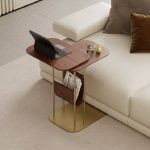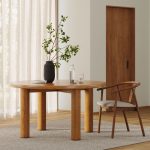The coffee table, often the centerpiece of your living room, plays a pivotal role in both functionality and aesthetics. But what should it match to create a cohesive and visually pleasing space? While there’s no one-size-fits-all answer, several key factors and design principles can guide you towards selecting a coffee table that harmonizes with your existing decor and elevates the overall ambiance of your living room. Let’s explore these considerations and unlock the secrets to achieving a balanced and stylish space. What should your coffee table match?
The Sofa: A Natural Pairing
What should your coffee table match? The sofa, often the largest and most prominent piece of furniture in the living room, serves as a natural anchor. Consider these factors when coordinating the two.
-
Size and Scale: The size and scale of your coffee table should be proportionate to your sofa. A large, sprawling sectional might call for a larger coffee table, while a smaller loveseat would pair better with a more compact option.
-
Height: Ideally, the coffee table should be slightly lower than the seat cushions of your sofa, allowing for comfortable access to drinks or snacks while seated.
-
Shape: The shape of your coffee table can complement or contrast with the shape of your sofa.
-
Rectangular Sofa: A rectangular coffee table creates a classic and balanced look with a rectangular sofa. You can also opt for a round or oval coffee table to soften the lines and add a touch of visual interest.
-
Sectional Sofa: A rectangular or square coffee table can anchor a sectional sofa and provide ample surface area for various activities.
-
Curved Sofa: A round or oval coffee table complements the curves of a curved sofa, creating a harmonious flow in the space.
-
Other Furniture Pieces: Creating a Cohesive Look
While the sofa is the primary consideration, it’s also essential to harmonize your coffee table with other furniture pieces in the room.
Accent Chairs
If you have accent chairs in your living room, ensure the coffee table’s height complements their seat height. You should be able to comfortably reach your coffee from the chairs.
Side Tables
If you have side tables flanking your sofa, consider their style and material when choosing your coffee table. A cohesive look can be achieved by selecting a table that shares similar elements or complements the design of your side tables.
TV Stand or Entertainment Center
If your living room features a TV stand or entertainment center, ensure the coffee table’s height and style harmonize with these pieces. Avoid a coffee table that’s too tall or bulky, as it can obstruct the view of the TV.
Décor Style: Reflecting Your Aesthetic
Your coffee table should also reflect your overall décor style and contribute to a cohesive aesthetic in your living room.
-
Modern and Minimalist: For modern or minimalist interiors, opt for coffee tables with clean lines, geometric shapes, and simple materials like metal, glass, or acrylic.
-
Traditional and Classic: If your décor leans towards traditional or classic styles, consider a coffee table made from wood with ornate details or a vintage-inspired design.
-
Rustic or Farmhouse: For a rustic or farmhouse aesthetic, a reclaimed wood table or one with a distressed finish can add warmth and character to your space.
-
Eclectic and Bohemian: Embrace a mix of styles and textures with an eclectic or bohemian-inspired coffee table. Consider a Moroccan-style table, a woven rattan piece, or even an upcycled vintage trunk.

Material Harmony: Creating a Cohesive Look
What should your coffee table match? The material of your coffee table plays a crucial role in establishing a cohesive and visually pleasing aesthetic in your living room.
-
Matching or Complementing: If your sofa or other key furniture pieces are upholstered in leather or fabric, consider a coffee table with a similar material or one that complements the texture and color scheme.
- Leather Sofa: A leather coffee table or one with a leather top can create a luxurious and harmonious look.
- Fabric Sofa: A wooden coffee table with a natural finish or a glass-topped table with a metal base complements most fabric sofas.
-
Contrasting Materials: You can also create visual interest by contrasting materials. For example, pair a sleek glass coffee table with a plush velvet sofa or a rustic wooden table with a modern leather sectional.
-
Mixed Materials: Some coffee tables feature a combination of materials, such as a wooden base with a marble top or a metal frame with a glass top. These mixed-material designs offer versatility and can complement various décor styles.
Material Considerations
-
Durability: Choose materials that are durable and can withstand everyday use. Wood, metal, and glass are all popular choices for their longevity.
-
Maintenance: Consider the maintenance requirements of different materials. Wood might require occasional polishing or refinishing, while glass or metal surfaces are generally easier to clean.
-
Lifestyle: If you have young children or pets, opt for durable and easy-to-clean materials that can withstand spills and scratches.
Color Coordination: Creating a Harmonious Palette
The color of your coffee table should blend seamlessly with the overall color scheme of your living room.
-
Neutral Tones: Neutral colors like black, white, brown, or gray are versatile and complement most décor styles. They offer a timeless backdrop for colorful accents or statement pieces.
-
Complementary Colors: If you want to add a pop of color, choose a coffee table in a shade that complements the dominant colors. Refer to the color wheel for inspiration and choose colors that sit opposite each other or create a harmonious triad.
-
Matching Wood Tones: If you have other wooden furniture in the room, consider matching the coffee table’s wood tone. Alternatively, you can choose a contrasting wood tone to create visual interest.

Color Tips:
-
Warm vs. Cool Tones: Consider the overall tone of your room. Warm colors like brown, red, or orange create a cozy and inviting atmosphere, while cool colors like blue, green, or gray evoke a sense of calmness and serenity.
-
Accent Colors: Use your table to introduce an accent color into your décor. A brightly colored table or one with a patterned top can add a playful touch to a neutral room.
Beyond Aesthetics: Functionality and Lifestyle
Beyond its visual appeal, your coffee table should also serve your practical needs and lifestyle.
-
Storage: If you need extra storage space, consider a coffee table with drawers, shelves, or a lift-top design.
-
Size and Shape: Choose a table that’s proportionate to the size of your room and your seating arrangement. A large coffee table can overwhelm a small space, while a tiny table might get lost in a living room.
-
Material and Finish: Consider your lifestyle and how you’ll be using the table. If you have young children or pets, opt for durable and easy-to-clean materials and finishes.
-
Additional Features: Some coffee tables come with additional features like built-in casters for easy movement.

Conclusion
What should your coffee table match? Choosing the perfect coffee table involves a thoughtful balance of aesthetics, functionality, and personal style. By considering its relationship with your sofa, other furniture pieces, and the overall décor of your living room, you can select a table that not only looks beautiful but also serves your practical needs and enhances your everyday living experience.
Remember, the coffee table is often the heart of your living room, where conversations flow, games are played, and memories are made. So, choose wisely, invest in a piece that you love, and let it become a cherished part of your home for years to come.


